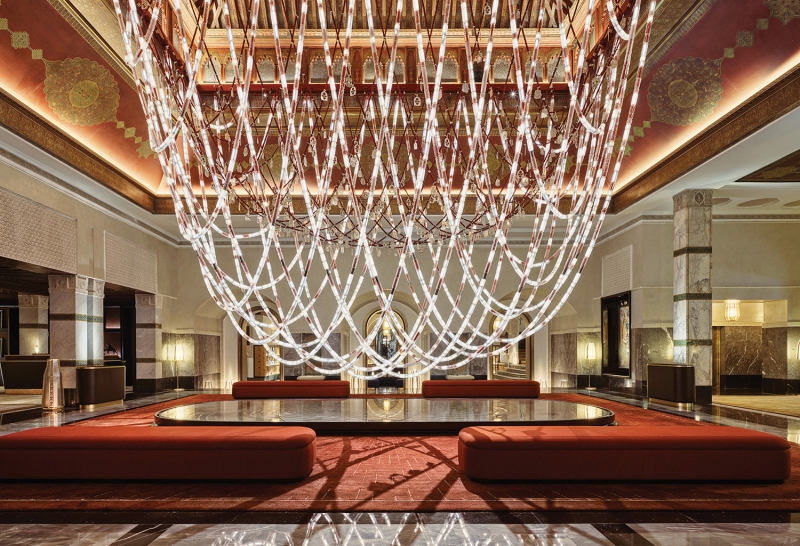Contents
- 1 Patrick Jouin Goes Back To The Basics With His Furniture Collection
- 1.1 Interior Design: For nearly 30 years, Patrick Jouin iD has designed furniture for brands such as Pedrali and Porada, as well as custom pieces for various Jouin Manku projects. Why launch your own collection now?
- 1.2 ID: What was your general approach to creating the collection?
- 1.3 ID: The Drop table looks like a color-field painting. How did that evolve?
- 1.4 ID: Tell us about the Flip stoneware plates, which seem to use the same decorative technique as the tables.
- 1.5 ID: The Mate folding leather stool looks both chic and practical, like a Birkin bag.
- 1.6 ID: Jouin Manku has just completed the second phase of renovating the very grand hotel La Mamounia in Marrakesh. What’s new there?
- 1.7 Explore The Range Of Furnishings In Patrick Jouin’s New Collection
- 1.8 Patrick Jouin Channels Savoir-Faire Into Furnishings
Inspired by Berber necklaces and Champagne, the chandelier above the lobby’s reflecting pool, part of the second-phase renovation of La Mamounia hotel in Marrakesh, Morrocco. Photography by Anson Smart.
Interior Design Hall of Fame member Patrick Jouin is one of the most prolific, versatile, and successful French multitalents on the international scene today. After earning a degree from the École Nationale Supérieure de Création Industrielle in Paris, Jouin spent five years working for Philippe Starck, who introduced him to furniture design and taught him the value of curiosity, before founding his eponymous practice in 1998. Early achievements include the nifty nylon-and-teak Tarti’nutella spatula (2003), now in the Centre Pompidou’s permanent collection, and the poetic Solid C2 chair (2004) in 3-D printed resin, also owned by several institutions. His first interiors commission—a glamorous restaurant in Paris’s Hôtel Plaza Athénée for superstar chef Alain Ducasse in 2000—initiated a series of dazzling hospitality, retail, and public-space projects around the globe.
In 2006, the designer broadened his purview, teaming up with architect Sanjit Manku to form Jouin Manku, a separate multidisciplinary studio focused on large-scale projects—hotels, restaurants, stores, even residences—that blend design and architecture seamlessly. Long-term collaborations include 14 restaurants for Ducasse, 10 locations for jeweler Van Cleef & Arpels—the latest, a glittering, latticework-clad building in Seoul, South Korea—and the three-phase renovation of the century-old La Mamounia hotel in Marrakesh, Morocco, the second stage recently completed. One-off projects have been remarkably diverse, ranging from a sprawling hilltop house in Kuala Lumpur, Malaysia, to the sensitive transformation of a medieval priory at the Abbaye de Fontevraud in Anjou, France, into a hotel and restaurant that preserves its austerely beautiful original envelope.
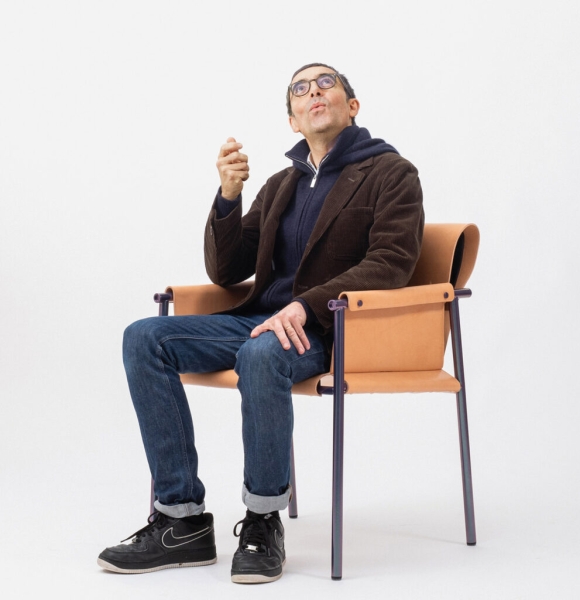
The founder of industrial design studio Patrick Jouin iD and cofounder of architecture and design firm Jouin Manku, both based in Paris, seated in the Olo armchair, also part of the edition.
In fact, a folding oak chair created for Fontevraud’s refectory-style banquet hall—“It can be hung flat on the wall,” Jouin notes, “very practical and monklike”—has been revived as part of the new Patrick Jouin Edition, a small, eclectic furniture collection that includes another chair, a table, a folding stool, and flippable stoneware plates. It’s his first foray into producing pieces under his own name. We spoke with him about the collection and other recent projects.
Patrick Jouin Goes Back To The Basics With His Furniture Collection
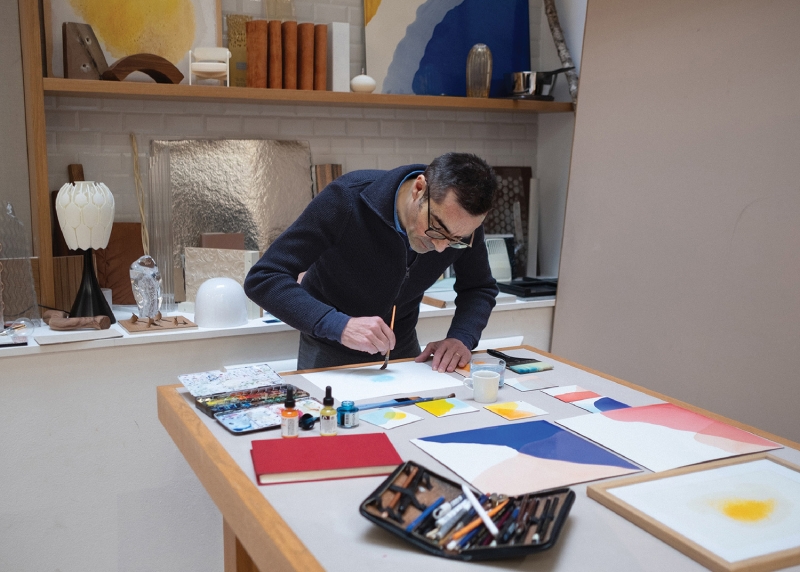
Jouin working on preparatory sketches in watercolor—a favorite medium—for the Drop tables. Photography by C. Seuleusian.
Interior Design: For nearly 30 years, Patrick Jouin iD has designed furniture for brands such as Pedrali and Porada, as well as custom pieces for various Jouin Manku projects. Why launch your own collection now?
Patrick Jouin: It’s a different exercise designing furniture for a specific brand that has its own DNA and story, or for a restaurant or hotel, where you have the constraints of a particular context and brand, too. Here, I would say, I’m in a free world—I can do whatever I want. Maybe it’s getting older, but I want that freedom more and more.
ID: What was your general approach to creating the collection?
PJ: Often, I start from a material. The Olo chair was about leather, which can be soft and flexible but also hard like wood. When you look at it, the leather on the steel frame looks rigid, but when you sit in it, there’s a hidden rubber element that allows it to fit the shape of the body. The structure is very simple, closely linked to the first one I ever designed: the steel Facto chair for Fermob.
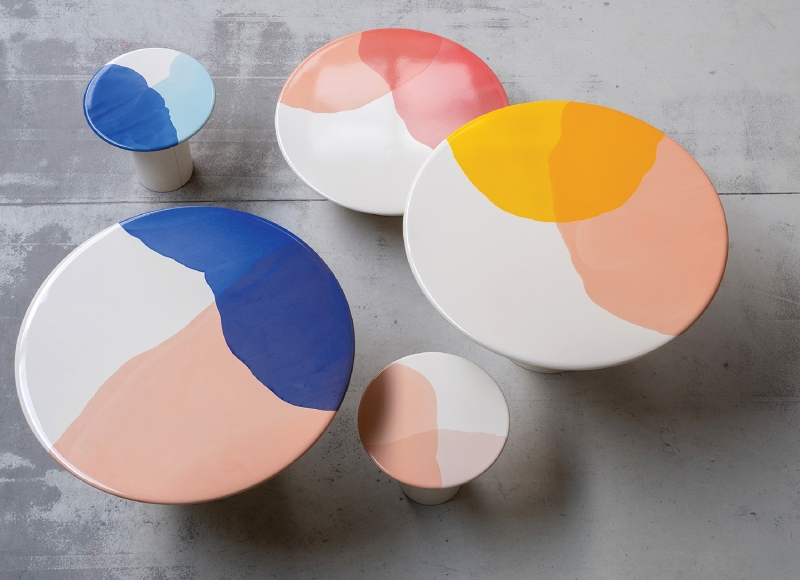
Three versions of the Drop table, dining, coffee, and side, each one unique. Photography by Adrien Dirand.
ID: The Drop table looks like a color-field painting. How did that evolve?
PJ: I’m not really a painter, but I enjoy working with watercolor and oil on wood—not with a brush, but by pouring on pigment like Jackson Pollock, except flat and without big gestures. I asked an enamelist if she could use the same technique on a steel table—something she’d never done before—but it works beautifully. Four layers of enamel paint are poured on and baked separately, one after another. There’s a dining table, a coffee table, and a side table—each one’s unique, like a painting, with a bit of Frank Stella in there too, maybe, because I love his work.
ID: Tell us about the Flip stoneware plates, which seem to use the same decorative technique as the tables.
PJ: Yes, but with glaze rather than enamel. The plates are something quite personal, from when I was a kid in the French countryside. My mother was a very busy nurse who needed to be super efficient, so for the evening meal, we’d always have a bowl of soup. Once that was finished, you’d turn over the bowl and use the back of it for dessert. I love that commonsense approach to things, so I played with it. Each of the Flip plates can be used two ways, like a game, and they also make a set with the tables—something I don’t think has been done before but is funny and delightful.
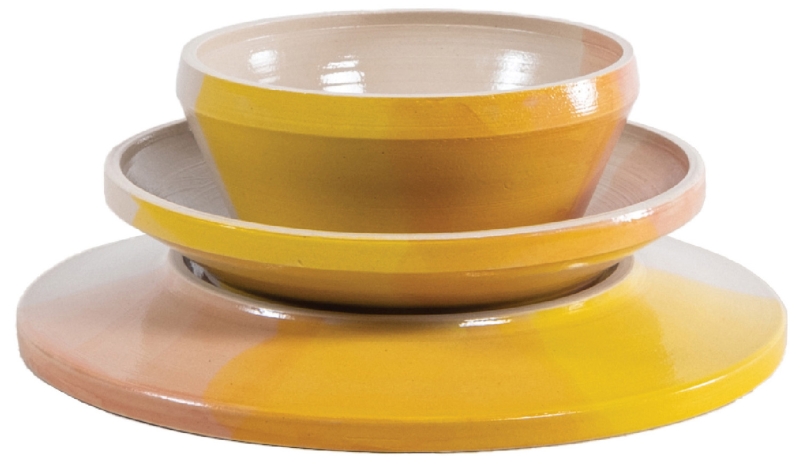
Flip double-sided stoneware bowls patterned like the Drop tables.
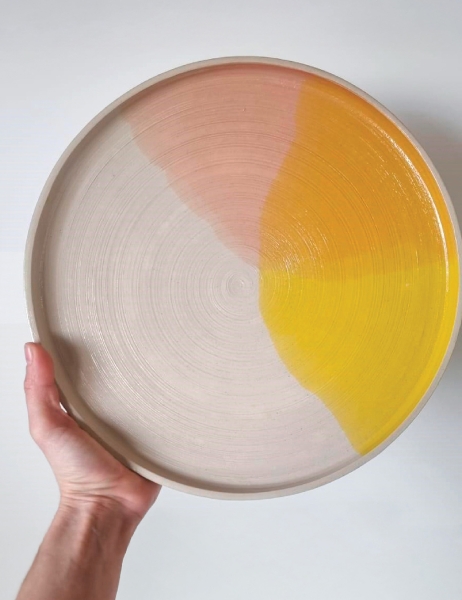
Flip double-sided stoneware plates, patterned like the Drop tables.
ID: The Mate folding leather stool looks both chic and practical, like a Birkin bag.
PJ: In fact, we originally created it as a foldup tableside perch for handbags in a Ducasse restaurant. We took the folding idea and made a stool that doesn’t take up space in your home. It can be hidden anywhere but when you need a seat, it opens up in just one gesture, like magic. It’s made of leather over aeronautical plywood—super thin, but very stiff and stable, so a big person can sit on it safely.
ID: Jouin Manku has just completed the second phase of renovating the very grand hotel La Mamounia in Marrakesh. What’s new there?
PJ: This time, we worked on the common areas—mainly the lobby, including a huge chandelier that welcomes guests as they arrive. Part of the inspiration for it was Berber necklaces, which are typically a simple string with lots of elements added symmetrically and perhaps something large and heavy at the bottom. So we used silver beads and Fatima hands to create one chandelier, then surrounded it with a second layer of crystals and LEDs to evoke the sparkle and glamour of Champagne. It’s very simple—a beautiful catenary shape formed naturally by gravity.
Explore The Range Of Furnishings In Patrick Jouin’s New Collection
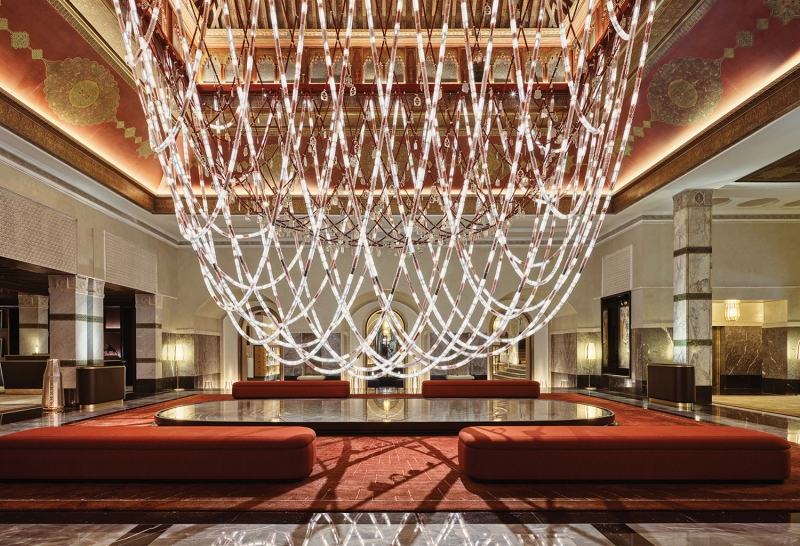
Inspired by Berber necklaces and Champagne, the chandelier above the lobby’s reflecting pool, part of the second-phase renovation of La Mamounia hotel in Marrakesh, Morrocco. Photography by Anson Smart.
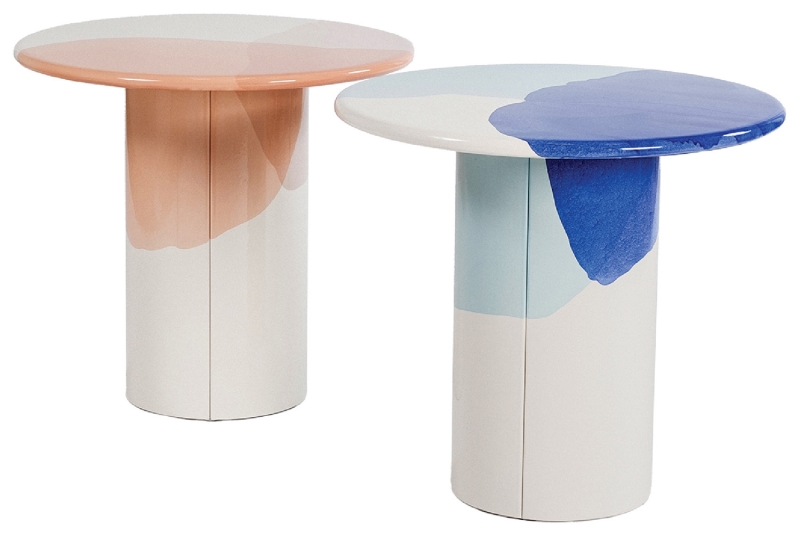
A pair of Drop side tables, made of spun steel finished in hand-poured enamel, from the Patrick Jouin Edition, a new five-piece furniture and tableware collection.
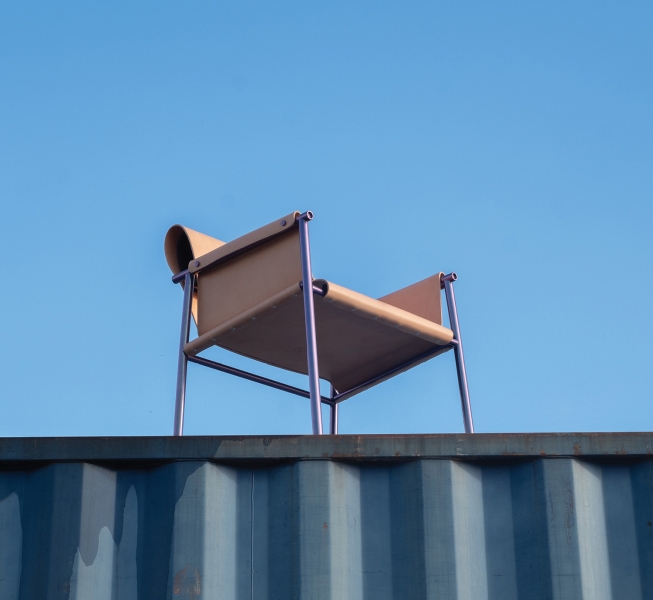
The Olo chair in leather and steel tube. Photography by C. Seuleusian.
Patrick Jouin Channels Savoir-Faire Into Furnishings
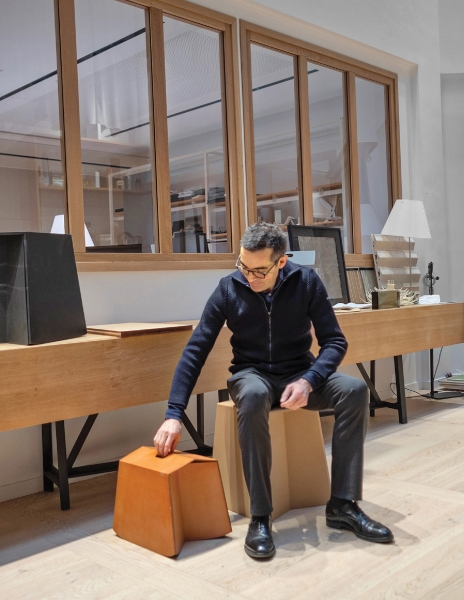
The designer in his Paris atelier with the Mate folding stool. Photography by Adrien Dirand.
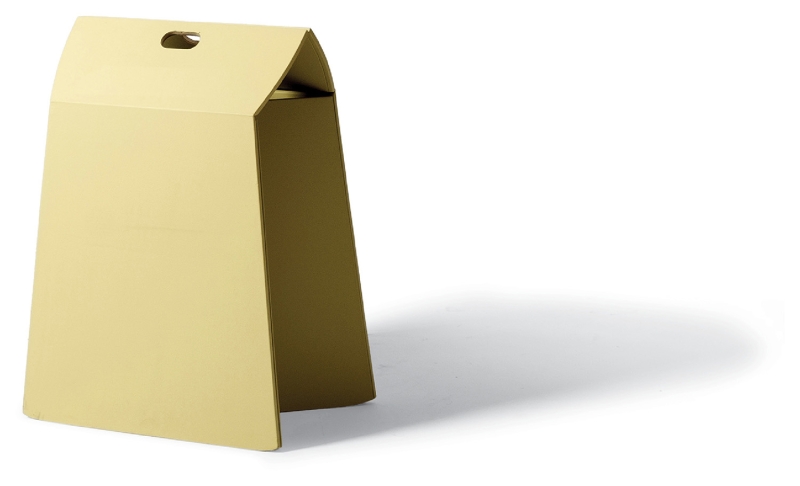
Underlying the leather exterior, strong and light aeronautical plywood. Photography by Adrien Dirand.
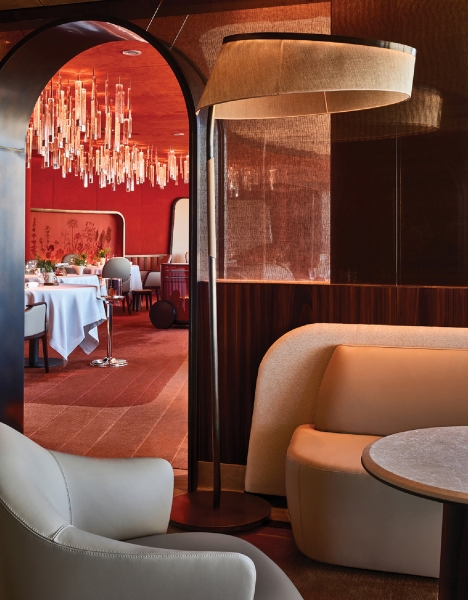
Atop the Rome Cavalieri hotel, the terra-cotta hues of the city’s architecture transposed to the interior of La Pergola restaurant, a recent project. Photography by Lorenzo Bataloni Per Studio Ventuno.
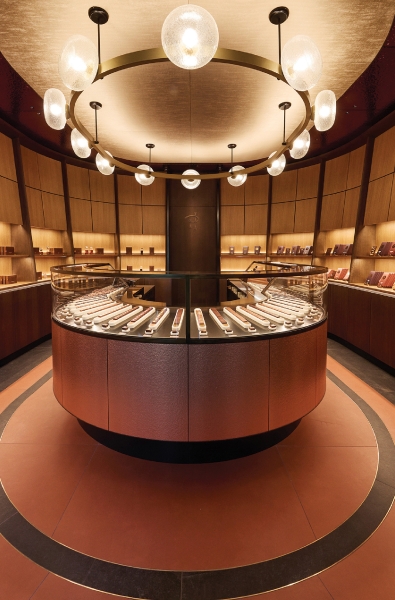
Infiniment Chocolat, a new Paris boutique for master pastry chef Pierre Hermé, with chocolates arrayed like an orgue à parfums, a perfumer’s tiered workstation resembling a church organ. Photography by Adrien Dirand.
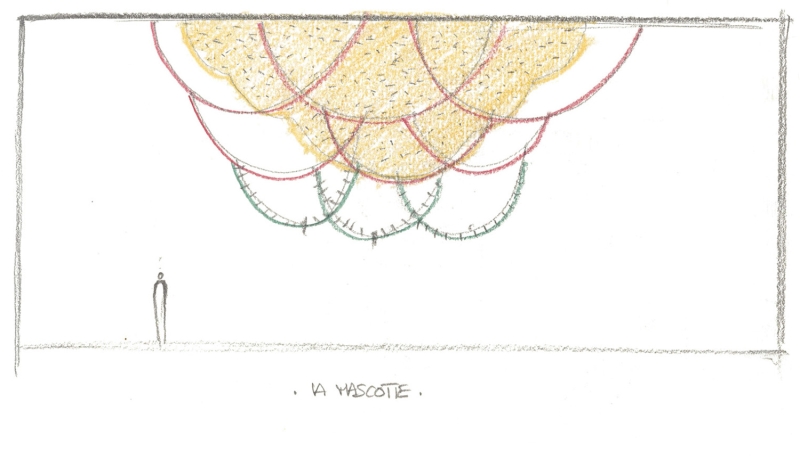
Jouin’s sketch for the chandelier, comprising a series of simple catenary forms. Photography by Jouin Maku.
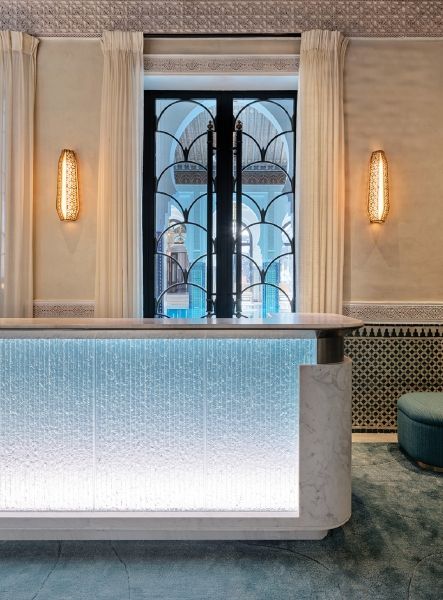
The hotel spa’s reception desk fronted with bush-hammered glass, its vertical striations resembling a waterfall frozen in motion. Photography by Anson Smart.
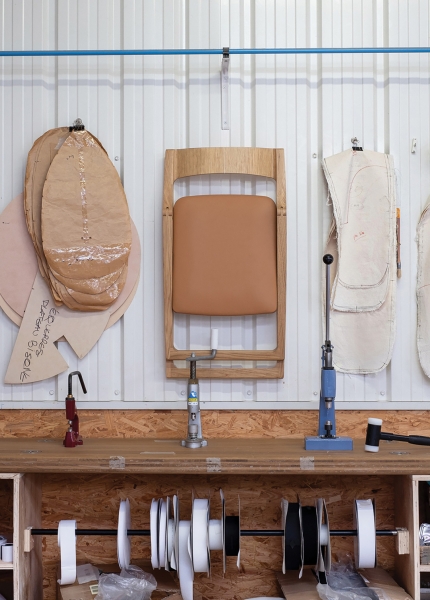
Originally developed for a hotel and restaurant at the medieval Abbaye de Fontevraud, in Anjou, France, the Monk folding oak chair hanging neatly on the wall. Photography by C. Seuleusian.

